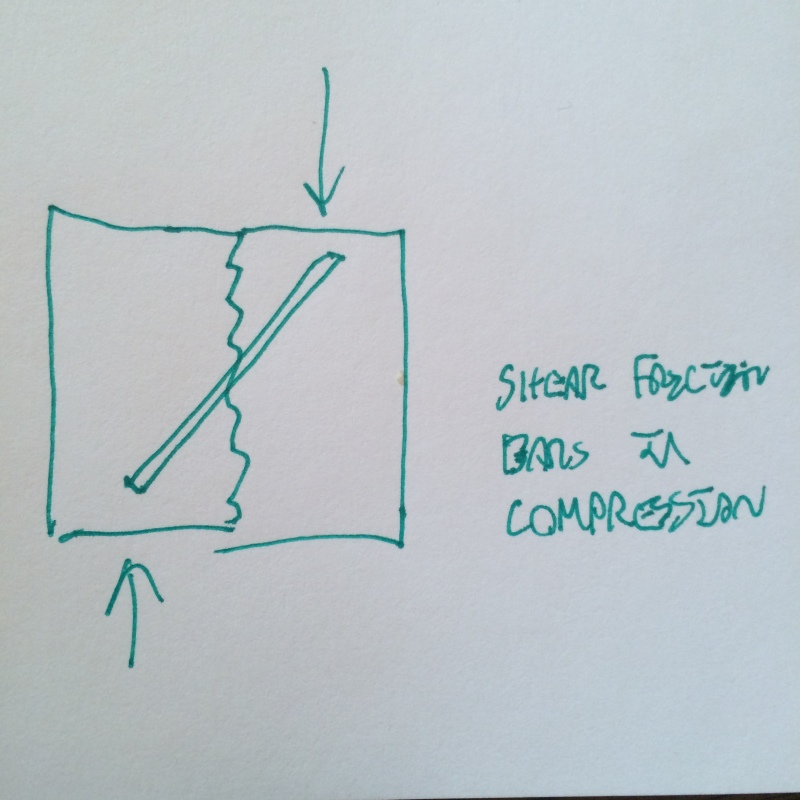perfectaccess
Structural
I am looking for the concept of direct shear in ACI code
I found section 11.6 which speaks about friction shear and it seems not related to my concern. However section 11.7 speaks about deep beam (transfer beams and direct shear) so my question are explained in points:
1. for section 11,7 it seems that to avoid direct shear your concrete stress should be less than 0.83*0.75*square root of (fc), and it subjected to minimum area of steel ,however increase steel will not help in the direct shear(as per the code(conservatively I think).
2. In section 11.6 ,it takes the effect of steel ,but it seems not for deep beams, I can’t till anyone I know implement such section???purpose???
3. In section 11.6 ,I quote
If a resultant tensile force acts across a shear
plane, reinforcement to carry that tension should be
provided in addition to that provided for shear transfer.
Tension may be caused by restraint of deformations due to
temperature change, creep, and shrinkage. Such tensile
forces have caused failures, particularly in beam bearings.
When moment acts on a shear plane, the flexural tension
stresses and flexural compression stresses are in equilibrium.
There is no change in the resultant compression Avf fy acting
across the shear plane and the shear-transfer strength is not
changed. It is therefore not necessary to provide additional
reinforcement to resist the flexural tension stresses, unless the
required flexural tension reinforcement exceeds the amount
of shear-transfer reinforcement provided in the flexural
tension zone. This has been demonstrated experimentally.11.51
It has also been demonstrated experimentally11.44 that if a
resultant compressive force acts across a shear plane, the
shear-transfer strength is a function of the sum of the resultant
compressive force and the force Avf fy in the shear-friction
reinforcement. In design, advantage should be taken of
the existence of a compressive force across the shear plane
to reduce the amount of shear-friction reinforcement
required, only if it is certain that the compressive force is
permanent.
Does this statement means
1 if you have pure tension ignore concrete and use additional Shear Reinforcement (other than what required in design)
2. if you pure compression use concrete friction and the same required area of steel used for design to resist shear if enough
3. if you have flexure Ignore concrete effect and use same area of steel required by design if enough.
My main problem of understanding is between flexure and compression.
I found section 11.6 which speaks about friction shear and it seems not related to my concern. However section 11.7 speaks about deep beam (transfer beams and direct shear) so my question are explained in points:
1. for section 11,7 it seems that to avoid direct shear your concrete stress should be less than 0.83*0.75*square root of (fc), and it subjected to minimum area of steel ,however increase steel will not help in the direct shear(as per the code(conservatively I think).
2. In section 11.6 ,it takes the effect of steel ,but it seems not for deep beams, I can’t till anyone I know implement such section???purpose???
3. In section 11.6 ,I quote
If a resultant tensile force acts across a shear
plane, reinforcement to carry that tension should be
provided in addition to that provided for shear transfer.
Tension may be caused by restraint of deformations due to
temperature change, creep, and shrinkage. Such tensile
forces have caused failures, particularly in beam bearings.
When moment acts on a shear plane, the flexural tension
stresses and flexural compression stresses are in equilibrium.
There is no change in the resultant compression Avf fy acting
across the shear plane and the shear-transfer strength is not
changed. It is therefore not necessary to provide additional
reinforcement to resist the flexural tension stresses, unless the
required flexural tension reinforcement exceeds the amount
of shear-transfer reinforcement provided in the flexural
tension zone. This has been demonstrated experimentally.11.51
It has also been demonstrated experimentally11.44 that if a
resultant compressive force acts across a shear plane, the
shear-transfer strength is a function of the sum of the resultant
compressive force and the force Avf fy in the shear-friction
reinforcement. In design, advantage should be taken of
the existence of a compressive force across the shear plane
to reduce the amount of shear-friction reinforcement
required, only if it is certain that the compressive force is
permanent.
Does this statement means
1 if you have pure tension ignore concrete and use additional Shear Reinforcement (other than what required in design)
2. if you pure compression use concrete friction and the same required area of steel used for design to resist shear if enough
3. if you have flexure Ignore concrete effect and use same area of steel required by design if enough.
My main problem of understanding is between flexure and compression.

